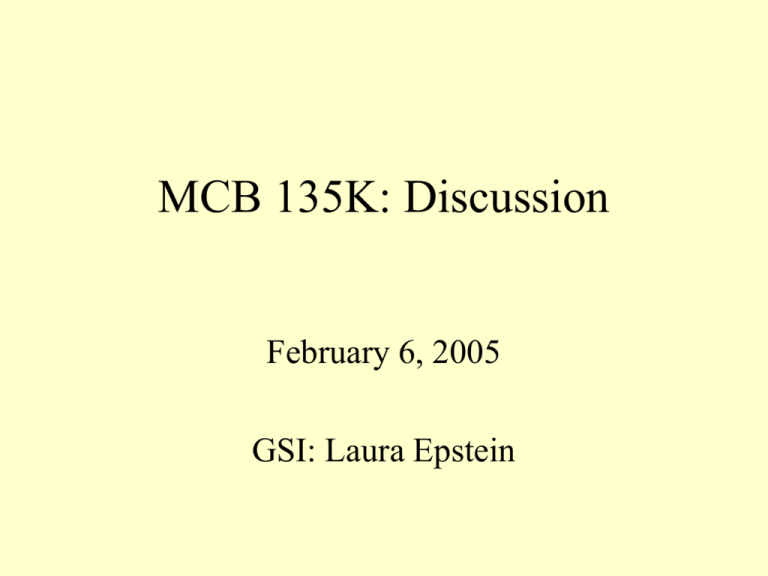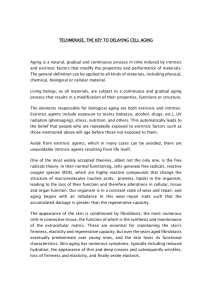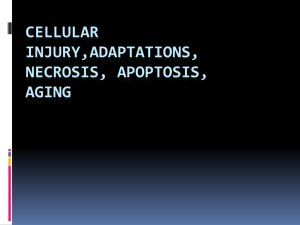February 6, 2006
advertisement

MCB 135K: Discussion February 6, 2005 GSI: Laura Epstein Topics 1. Epidemiology of Aging 2. Telomeres EPIDEMIOLOGY OF AGING • THE STUDY OF THE AGE-RELATED DISTRIBUTION AND CAUSES OF DISEASE, DISABILITY, AND MORTALITY IN HUMAN POPULATIONS. EPIDEMIOLOGY OF AGING • WHY IMPORTANT? – AGING OF THE HUMAN POPULATION – HEALTH AND VITALITY OF AN AGING POPULATION – QUALITY OF LIFE AND COST OF CARE EPIDEMIOLOGY OF AGING • CHRONOLOGICAL AGE IS ASSOCIATED WITH INCIDENCE AND PREVALENCE OF MOST HEALTH OUTCOMES. • DESPITE THIS AGE ASSOCIATION, THERE IS CONSIDERABLE VARIATION IN HEALTH OUTCOMES WITHIN AGE CATEGORIES. EPIDEMIOLOGY OF AGING • WHY ARE OLDER PEOPLE AT ELEVATED RISK FOR DISEASE, DISABILITY, AND DEATH? • ACCUMULATION OF ENVIRONMENTAL/BEHAVIORAL INSULTS. • REDUCED IMMUNOLOGICAL SURVEILLANCE EPIDEMIOLOGY OF AGING EPIDEMIOLOGY OF AGING • AGING OF THE U.S. POPULATION, PERCENTAGE AGED 65+ YEARS BY YEAR 1900 1940 1980 2000 2030 4.0% 8.0% 11.5% 12.6% 20.0% EPIDEMIOLOGY OF AGING • THERE IS CONSIDERABLE VARIABILITY BY REGION OF THE COUNTRY, 2000 – FLORIDA – CALIFORNIA – ALASKA 18.1% 10.4% 5.8% EPIDEMIOLOGY OF AGING • RACE, ETHNICITY, AND AGE, U.S. 2000 2050 NH white 83.5% NH black 8.1 NH Asian/PI 2.4 Hispanic 5.6 64.2% 12.2 6.5 16.4 EPIDEMIOLOGY OF AGING • Global Differences in the Aging of the Population – Number of years required to increase the percentage of people aged 65+ from 7% to 14%. – – – – France: 115 years (1865-1980) Japan: 26 years (1970-1996) Chile: 20 years (2000-2020) Tunisia 15 years (2020-2035) Elderly Support Ratio, 2000-2030 • Ratio = Number of people aged 65+ per 100 aged 20-64 • USA – 2000 – 2030 21 per 100 37 per 100 Elderly Support Ratio 2000-2030 • • • • • Italy Japan China India Guatemala 2000 29 27 12 9 8 2030 49 52 26 15 11 EPIDEMIOLOGY OF AGING • MAJOR AGE-ASSOCIATED CAUSES OF DEATH – CARDIOVASCULAR DISEASE – CANCER – CHRONIC OBSTRUCTIVE PULMONARY DISEASE – DIABETES EPIDEMIOLOGY OF AGING AGE-SPECIFIC COLORECTAL CANCER INCIDENCE RATES (Per 100,000 in population) <65 65+ WM WF BM BF 20.4 14.7 25.3 20.4 408.0 269.3 385.8 286.1 EPIDEMIOLOGY OF AGING • COGNITIVE FUNCTION • Moderate/Severe Memory defined as four or fewer words recalled (out of 20) on combined immediate and delayed recall tests. Source: Health and Retirement Survey. • • 65-69 • 85+ Male 5.3 37.3 Female 3.8 35.0 EPIDEMIOLOGY OF AGING • DEPRESSIVE SYMPTOMS Males • 65-69 • 85 + 12.1 22.5 Females 18.0 23.0 EPIDEMIOLOGY OF AGING • PERCENT OF MEN AND WOMEN AGED 60+ REPORTING TWO OR MORE HEALTH CONDITIONS • MEN WOMEN • 60-69 35 45 • 70-79 47 61 • 80+ 53 70 EPIDEMIOLOGY OF AGING • FALLS • 30% OF PEOPLE AGED 65+ FALL EACH YEAR. • 10-15% OF THOSE FALLS ARE CONSIDERED “SERIOUS/NON-FATAL” • FALLS REPRESENT THE LEADING CAUSE OF ACCIDENTAL DEATH IN PEOPLE AGED 65 AND OLDER. • FEAR OF FALLING IS A LEADING REASON FOR NOT ENGAGING IN PHYSICAL ACTIVITY. EPIDEMIOLOGY OF AGING • CAUSES OF FALLS IN THE ELDERLY • - DIZZINESS • - POOR COGNITIVE FUNCTION • - VISION PROBLEMS • - GENERAL FRAILTY • - ENVIRONMENTAL HAZARDS EPIDEMIOLOGY OF AGING • Types of studies – – – – – Clinic/Laboratory-Based Studies Adapted Population Studies Established Population Studies Special General Population Studies Special Chronic Disease Studies • Types of Research Designs – Case-Control Studies – Longitudinal or Prospective Studies EPIDEMIOLOGY OF AGING • STRATEGIES TO ENHANCE HEALTH AND FUNCTIONING THROUGH PHYSICAL ACTIVITY—it seems to be an “elixir” – RWJ PROGRAM IN “ACTIVE FOR LIFE” – RWJ PROGRAM IN “ACTIVE ENVIRONMENTS” Questions • Why are older people at elevated risk for disease, disability and death? • In the US, which age/ethnic group will increase the most between 2000 and 2050? • Who has a higher frequency of 2 or more health conditions, men or women? • Why is it important to look at the epidemiology of falls, and why are we concerned about this? TELOMERES What are they? Why are they important? Telomere shortening and the end-replication problem Telomerase Telomere hypothesis of aging Telomeres Ends of linear chromosomes Centromere Telomere Telomere Repetitive DNA sequence (TTAGGG in vertebrates) Specialized proteins Form a 'capped' end structure TELOMERE STRUCTURE 5’ 3’ Telomeric t loop 5' 3' NUCLEAR MATRIX Telomeric proteins: TRF1 TRF2 TIN2 RAP1 TANKS 1,2 POT1 etc Why are telomeres important? Telomeres allow cells to distinguish chromosomes ends from broken DNA Stop cell cycle! Repair or die!! Homologous recombination (error free, but need nearby homologue) Non-homologous end joining (any time, but error-prone) Why are telomeres important? Prevent chromosome fusions by NHEJ NHEJ FUSION BRIDGE Mitosis BREAKAGE Fusion-bridge-breakage cycles Genomic instability Cell death OR neoplastic transformation Proliferative capacity Telomere also provide a means for "counting" cell division Finite Replicative Life Span "Mortal" Infinite Replicative Life Span "Immortal" Number of cell divisions How do cells "know" how many divisions they have completed?? The End Replication Problem: Telomeres shorten with each S phase 5' 3' 3' 5' 3' 5' 3' 5' 5' DNA replication is bidirectional Polymerases move 5' to 3' Requires a labile primer Ori Each round of DNA replication leaves 50-200 bp DNA unreplicated at the 3' end TELOMERASE: Key to replicative immortality + TELOMERASE Overcomes telomere shortening and the endreplication problem Expressed by germ cells, early embryonic cells Not expressed by most somatic cells (human) May be expressed by some stem cells, but highly controlled Expressed by 80-90% of cancer cells (remaining still need to overcome the end replication problem; do so by recombinational mechanisms -ALT (alternative lengthening of telomeres) mechanisms HOWEVER, CELLS THAT EXPRESS TELOMERASE STILL UNDERGO SENESCENCE (E.G., IN RESPONSE TO DNA DAMAGE, ONCOGENES, ETC.) Telomerase: Biomedical uses Expand cells for replacement therapies (burns, joint replacements, etc) Telomerase inhibitors to selectively kill cancer cells The telomere hypothesis of aging Telomeres shorten with each cell division and therefore with age TRUE Short telomeres cause cell senescence and senescent cells may contribute to aging TRUE HYPOTHESIS: Telomere shortening causes aging and telomerase will prevent aging TRUE OR FALSE? The telomere hypothesis of aging Telomere length is not related to life span (mice vs human; M musculus vs M spretus) Telomeres contribute to aging ONLY if senescent cells contribute to aging Telomerase protects against replicative senescence but not senescence induce by other causes SUMMARY Telomeres are essential for chromosome stability Telomere shortening occurs owing to the biochemistry of DNA replication Short telomeres cause replicative senescence (other senescence causes are telomere-independent) Telomerase prevents telomere shortening and replicative senescence The telomere hypothesis of aging depends on the cellular senescence hypothesis of aging Questions • • • • What are telomeres? Why are telomeres important? What is telomerase? True or false: Telomeres protect cells from ALL types of senescence. • What is the telomere hypothesis of aging?




